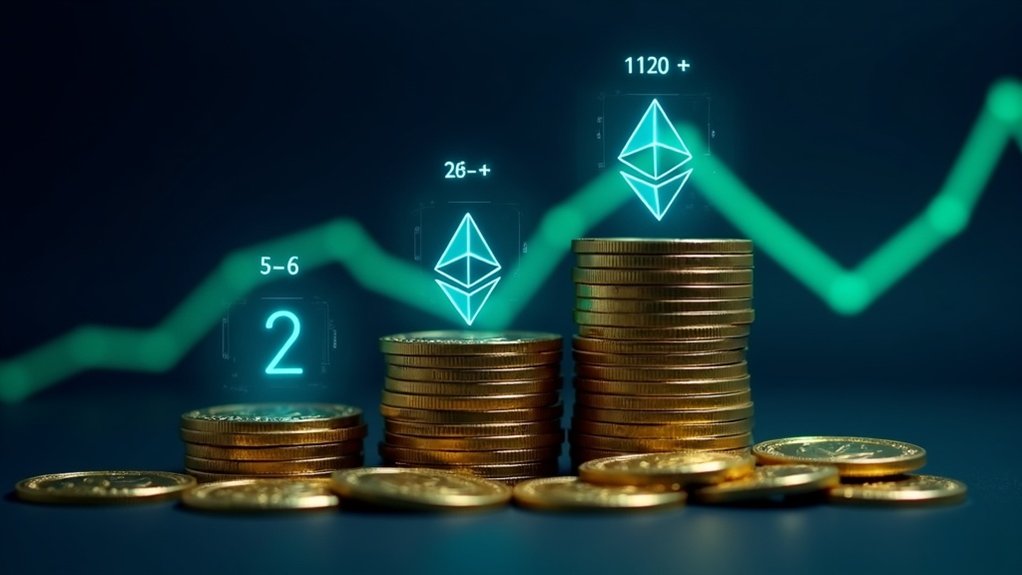Cryptocurrency market capitalization is calculated by multiplying a coin’s current price by its circulating supply. That’s it. Pretty simple math. For example, Bitcoin trading at $50,000 with 19 million coins in circulation equals a market cap of $950 billion. This formula works for any crypto, from industry giants to obscure altcoins. Market cap reveals a crypto’s true economic footprint beyond just price per coin. The deeper story lies beneath these numbers.
Why do cryptocurrency investors obsess over market capitalization? Simple. It tells them how big a crypto really is. Not the price per coin—that’s amateur hour. Market cap shows the actual economic footprint of a cryptocurrency in the vast digital landscape.
Market cap reveals a crypto’s true size in the ecosystem. Price per coin is just surface-level thinking.
Market capitalization is calculated by multiplying a cryptocurrency’s current price by its circulating supply. Nothing fancy. Just basic math. A crypto priced at $100 with 1 million coins in circulation has a market cap of $100 million. Done.
There are different flavors of market cap, each telling a slightly different story. Circulating market cap—the most common type—only counts coins currently available for trading. Bitcoin trading at $50,000 with 19 million coins in circulation? That’s a whopping $950 billion market cap. No wonder it dominates the charts.
Total market cap takes a broader view. It includes all existing coins, even those locked away or staked. Ethereum‘s total market cap, for instance, counts ETH that’s staked or hasn’t been issued yet. More extensive, but sometimes misleading. Like traditional stocks, market cap provides a clear measure of an asset’s total equity value.
Then there’s fully diluted market cap—the hypothetical value if every possible token existed today. Take a token with a maximum supply of 1 billion priced at $1. Fully diluted? $1 billion. Reality check: many of those tokens won’t see daylight for years.
Market caps aren’t static. They dance with price fluctuations and supply changes. New coins minted, old ones burned—the supply side is always shifting. That’s why market cap rankings shuffle like a deck of cards.
Investors use these numbers to categorize cryptos: large-cap, mid-cap, low-cap. Each category carries different risk profiles. Large-caps offer stability but limited growth. Low-caps? Higher risk, higher potential rewards. Classic trade-off.
Market cap cuts through the noise. A $1 coin isn’t necessarily cheaper than a $1,000 coin. Supply matters. Market cap provides context, letting investors compare apples to apples in the crypto orchard. That’s why it matters. The largest cryptocurrencies with over $10 billion market cap like Bitcoin and Ethereum demonstrate much greater stability and lower volatility than their smaller counterparts. The concept works universally for any asset type, making it a versatile tool across various investment categories.
Frequently Asked Questions
Why Does Market Cap Matter When Investing in Cryptocurrencies?
Market cap matters because it signals a cryptocurrency’s risk profile.
Higher caps usually mean less volatility, better liquidity, and easier large-trade execution.
It helps investors compare tokens across the ecosystem and informs portfolio allocation strategies.
But it’s not everything.
Market cap can be manipulated, especially with low-liquidity tokens.
And fully diluted valuations? Often misleading.
Smart investors use market cap as just one piece of the puzzle. Not the whole picture.
Can Market Cap Predict Future Cryptocurrency Prices?
Market cap alone can’t predict crypto prices. Period. It’s a snapshot, not a crystal ball.
Research shows market cap correlates with volatility (bigger = more stable, usually), but that’s it.
Smart investors combine it with other metrics like trading volume, on-chain activity, and token releases.
The numbers don’t lie – short-term price movements track more closely with liquidity and sentiment than market cap.
Big market cap coins can still crash spectacularly when things go south.
How Do Token Burns Affect Cryptocurrency Market Capitalization?
Token burns directly affect market cap in two ways.
First, they reduce circulating supply—fewer tokens means lower market cap if price stays constant.
Second, burns often trigger price increases due to perceived scarcity.
If price jumps enough, market cap actually rises despite fewer tokens.
Funny how that works.
Burns can be one-time events or scheduled programs.
Not all burns are created equal though—some are just PR stunts with minimal impact.
What Causes Sudden Changes in Cryptocurrency Market Caps?
Cryptocurrency market caps can swing wildly overnight.
Several culprits: large buy/sell orders (especially for small-cap tokens), whale movements, token releases flooding supply, and burns reducing it.
External factors hit hard too – regulatory announcements, exchange listings/delistings, and good old-fashioned market manipulation.
Data reporting errors? They happen.
Sometimes it’s just Bitcoin dragging everything else along.
Crypto markets don’t exactly prioritize stability. Never have, probably never will.
How Reliable Is Market Cap for Measuring Cryptocurrency Value?
Market cap is a flawed yardstick for crypto value. Period.
It’s easily manipulated through wash trading and supply misreporting.
Low-liquidity coins? Their market caps are basically fantasy numbers.
One whale makes a move, and suddenly the “value” swings wildly.
Sure, it gives you a snapshot of size, but it tells you nothing about fundamentals, adoption, or liquidity.
Different exchanges show different prices too.
Real value? That’s a whole other story.









